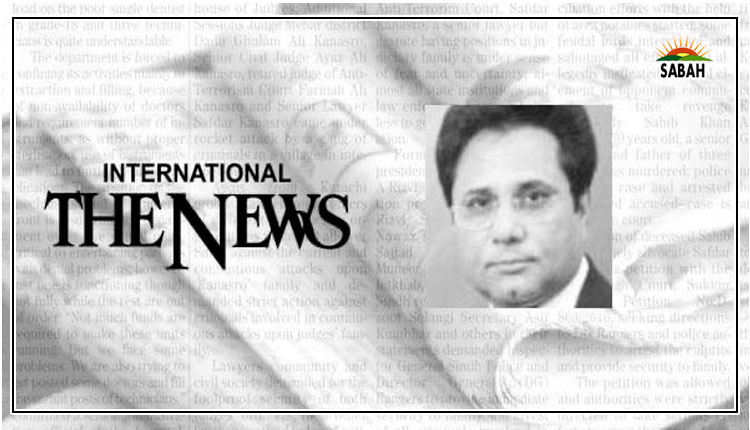Terrorism and drug trade…Dr Ikramul Haq
Today (June 26, 2023) marks the International Day against Drug Abuse and Illicit Trafficking. This worldwide observance was decided by the UNGA in 1987 to raise the level of awareness in the international community about the dangers of drug abuse, prevent its spread and encourage all efforts to combat the menace at the international level.
Each year the UN Office on Drugs and Crime (UNODC) selects the theme for the day and this year the theme is People first: stop stigma and discrimination, strengthen prevention.
The 2023 International Narcotics Control Strategy Report observes, revenue from poppy cultivation and the Afghan drug trade continues to contribute to Afghanistans internal conflicts, undermines the rule of law, fuels corruption, and contributes to high rates of substance use.
Terrorism, drugs-for-arms and money laundering are intrinsically linked and pose a considerable threat to global peace and security besides destabilizing the political and financial stability of many nation-states. We have already seen how this got accelerated in the wake of the 9/11 ghastly incident in New York.
Militants and extremists usually form a nexus with criminal networks involved in drug and arms. Evidence available with intelligence agencies confirms that, from Al Qaeda to Daesh, the real challenge is the free flow of legal and illegal funds. Till today, the international community has failed to sever their financial lifeline.
It is an open secret how the drug trade in post-Taliban Afghanistan was institutionalized, courtesy the regime in Kabul and patronization of warlords in many provinces of Afghanistan. Once opium started getting processed into morphine and heroin inside Afghanistan at a mass scale, it brought tons of money for commanders on the ground.
Controlled democracy in Afghanistan from 2004 to 2021 had been playing into the hands of more sophisticated naro-enriched commanders. It is no more a secret that the Taliban knew how to buy or muscle a vote which would protect their opium interests in every election.
Even the neighbours of Afghanistan were making profits from the windfall: criminal groups from Central Asia, says the UN, made profits of $15.2 billion from the trafficking of opiates in 2015 according to World Drug Report 2017 the figure for 2017 was $22.8 billion. Tajikistan is by far the worst affected by the drug plague, due to a combination of factors like the countrys history, poverty and its geographical location.
In the late 1990s, drug trade was believed to be a source of finance for the Islamic Movement of Uzbekistan (IMU), a terrorist group which had bases in Afghanistan and Tajikistan. After the war in Afghanistan, the IMU lost most of its influence, but the drugs trade continued, with organized criminals taking the place of political or religious activists.
In a survey conducted by the Open Society Institute, eight out of 10 of those polled said hardly surprisingly that the main reason to turn to drug trafficking was to make big money. Geography also contributed to Tajikistans drugs problem: at 1,400km, the countrys border with Afghanistan is longer than its Central Asian neighbours, and commensurately more difficult to guard.
Afghanistans north-eastern province of Badakhshan, an important poppy-growing area, is close to the border with Tajikistan. From there, most narcotics move to Uzbekistan and Kyrgyzstan before continuing to Kazakhstan and onwards to Russia.
China in 2015 observed that Southeast Asias lawless Golden Triangle region remains the overwhelming source of the heroin and methamphetamine used in the country. A cabinet report on Chinas drug situation released on June 24, 2015 underscored the threat posed by the region incorporating parts of Laos, Myanmar and Thailand, despite efforts at cross-border cooperation.
It said that 90 per cent of the 9.3 tons of heroin and 11.4 tons of methamphetamine seized in 2014 came from the area that borders Chinas southern province of Yunnan. The report was the governments first comprehensive look at drug use in China, where synthetic drugs such as methamphetamine and ketamine overtook heroin in popularity. It said China had by the end of 2013 about three million registered drug users, but estimates of those who had tried drugs ran as high as 14 million.
Three of Afghanistans five big drug-producing provinces Helmand, Uruzgan, and Kandahar have emerged as new Colombia, places where drug lords capture and wreck governments and the economy alike. Successive Afghan governments in the post-Taliban period made little progress against poppy-growing, except declaring it illegal and establishing a new policy body, the Counter-Narcotics Department (CND). The goal of 100 per cent elimination by 2013 proved a farce; in reality production was increased after the establishment of the CND as confirmed by the 2018 International Narcotics Control Strategy Report.
While the INCSR highlighted the spectre of the Taliban, it never discussed the widespread poverty in Afghanistan and the growing gap between rich and poor. For many local politicians, such economic factors, along with natural disasters and border problems, constituted far bigger headaches than the Taliban.
Human rights activists contend that the Taliban threat was intentionally exaggerated to crush all forms of dissent, religious or otherwise. But even those who were of the view that religious radicalism and terrorism were real dangers criticized the US-backed governments for not countering the Taliban through economic initiatives.
The Taliban, since ruling Afghanistan for the second time in the wake of the withdrawal of American troops in 2021, have proved their patronization of poppy cultivation and drug trade as highlighted in the 2023 International Narcotics Control Strategy Report that says: In 2022, according to UNODC, Afghanistan supplied 80 percent of the global opiate demand, including opium processed into heroin. Afghanistan also has one of the worlds largest populations suffering from substance use disorders.
The US could have played a useful role by acknowledging and supporting the efforts of Iran that waged all out crackdown on warlords and commanders engaged in drug trade. However, Americans were supporting them.
Courtesy The News












